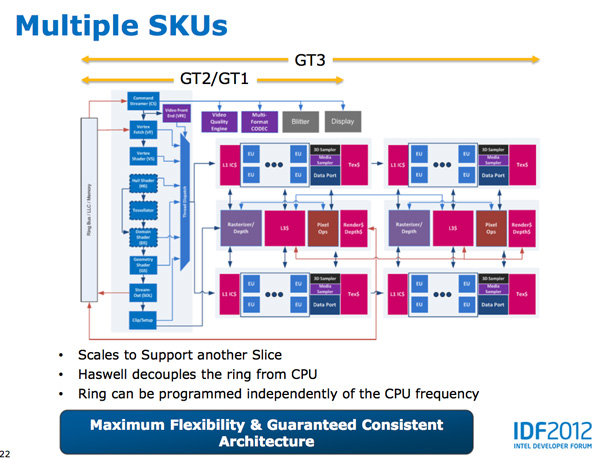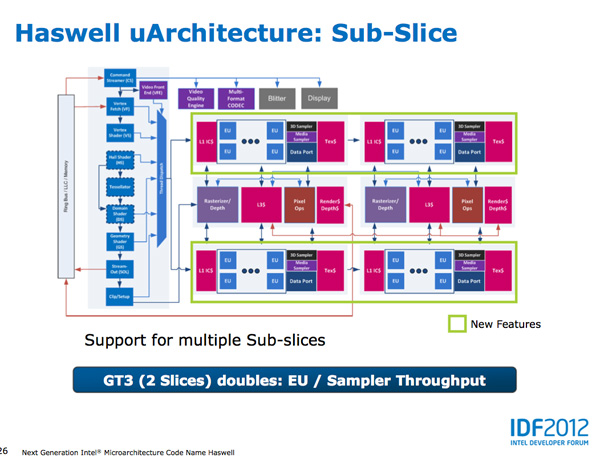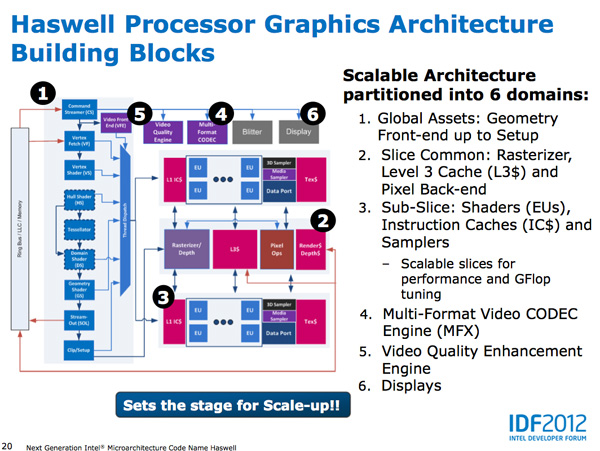Intel's Haswell Architecture Analyzed: Building a New PC and a New Intel
by Anand Lal Shimpi on October 5, 2012 2:45 AM ESTHaswell's GPU
Although Intel provided a good amount of detail on the CPU enhancements to Haswell, the graphics discussion at IDF was fairly limited. That being said, there's still some to talk about here.
Haswell builds on the same fundamental GPU architecture we saw in Ivy Bridge. We won't see a dramatic redesign/re-plumbing of the graphics hardware until Broadwell in 2014 (that one is going to be a big one).
Haswell's GPU will be available in three physical configurations: GT1, GT2 and GT3. Although Intel mentioned that the Haswell GT3 config would have twice the shader count of Haswell GT2, it was careful not to disclose the total number of EUs in any of the versions. Based on the information we have at this point, GT3 should be a 40 EU configuration while GT2 should feature 20 EUs. Intel will also be including up to one redundant EU to deal with the case where there's a defect in an EU in the array. This isn't an uncommon practice, but it does indicate just how much of the die will be dedicated to graphics in Haswell. The larger of an area the GPU covers, the greater the likelihood that you'll see unrecoverable defects in the GPU. Redundancy at the EU level is one way of mitigating that problem.
Haswell's processor graphics extends API support to DirectX 11.1, OpenCL 1.2 and OpenGL 4.0.
At the front of the graphics pipeline is a new resource streamer. The RS offloads some driver work that the CPU would normally handle and moves it to GPU hardware instead. Both AMD and NVIDIA have significant command processors so this doesn't appear to be an Intel advantage although the devil is in the (unshared) details. The point from Intel's perspective is that any amount of processing it can shift away from general purpose CPU hardware and onto the GPU can save power (CPU cores go to sleep while the RS/CS do their job).
Beyond the resource streamer, most of the fixed function graphics hardware sees a doubling of performance in Haswell.
At the shader core level, Intel separates the GPU design into two sections: slice common and sub-slice. Slice common includes the rasterizer, pixel back end and GPU L3 cache. The sub-slice includes all of the EUs, instruction caches and EUs.
In Haswell GT1 and GT2 there's a single slice common, while GT3 sees a doubling of slice common. GT3 similarly has two sub-slices, although once again Intel isn't talking specifics about EU counts or clock speeds between GT1/2/3.
The final bit of detail Intel gave out about Haswell's GPU is the texture sampler sees up to a 4x improvement in throughput over Ivy Bridge in some modes.
Now to the things that Intel didn't let loose at IDF. Although originally an option for Ivy Bridge (but higher ups at Intel killed plans for it) was a GT3 part with some form of embedded DRAM. Rumor has it that Apple was the only customer who really demanded it at the time, and Intel wasn't willing to build a SKU just for Apple.
Haswell will do what Ivy Bridge didn't. You'll see a version of Haswell with up to 128MB of embedded DRAM, with a lot of bandwidth available between it and the core. Both the CPU and GPU will be able to access this embedded DRAM, although there are obvious implications for graphics.
Overall performance gains should be about 2x for GT3 (presumably with eDRAM) over HD 4000 in a high TDP part. In Ultrabooks those gains will be limited to around 30% max given the strict power limits.
As for why Intel isn't talking about embedded DRAM on Haswell, your guess is as good as mine. The likely release timeframe for Haswell is close to June 2013, there's still tons of time between now and then. It looks like Intel still has a desire to remain quiet on some fronts.














245 Comments
View All Comments
CaptainDoug - Friday, October 5, 2012 - link
Quite the read. Very informational. Anandtech has some of the best tech writers. True online journalism. Sometimes i miss that while reading tech blogs... You guys are a cut above.. at least one.colonelclaw - Friday, October 5, 2012 - link
Couldn't agree more, this article really brightened up what was otherwise a pretty miserable afternoon here in London.When am I going to be able to walk into a shop and buy something with Haswell inside it? Next March maybe?
Kepe - Friday, October 5, 2012 - link
As stated in the article, Haswell is coming in the summer of 2013.linuxlowdown - Saturday, October 6, 2012 - link
Tag team Intel fanboy puke.Azethoth - Sunday, October 7, 2012 - link
How do I downvote stupid crap like this "Tag team Intel fanboy puke." comment so that collectively we can see high quality comments without having to wade through the interturds as well? It really takes away from the best article I have read in a long time. Not because it is about Intel, but because it is about the state of the art.medi01 - Tuesday, October 9, 2012 - link
Well, I'd also ask how do I downvote stupid butt kissing like OP, while we are at rating....Kisper - Saturday, October 20, 2012 - link
Many people enjoy well written and informative articles. Are you telling me that if you wrote, you would not enjoy positive feedback from your readers?CaptainDoug - Tuesday, October 23, 2012 - link
Exactly.actionjksn - Sunday, October 7, 2012 - link
Why are you even on this article dumb fuck? I'm sure there is something that is of interest to you on the internet somewhere.medi01 - Tuesday, October 9, 2012 - link
Not sure about him, but I've looked into this article to figure power targets for haswell (especially interesting to compare to ARM crowd), NOT to read orgasmic comments about eternal wizdom of Intel's engineering...